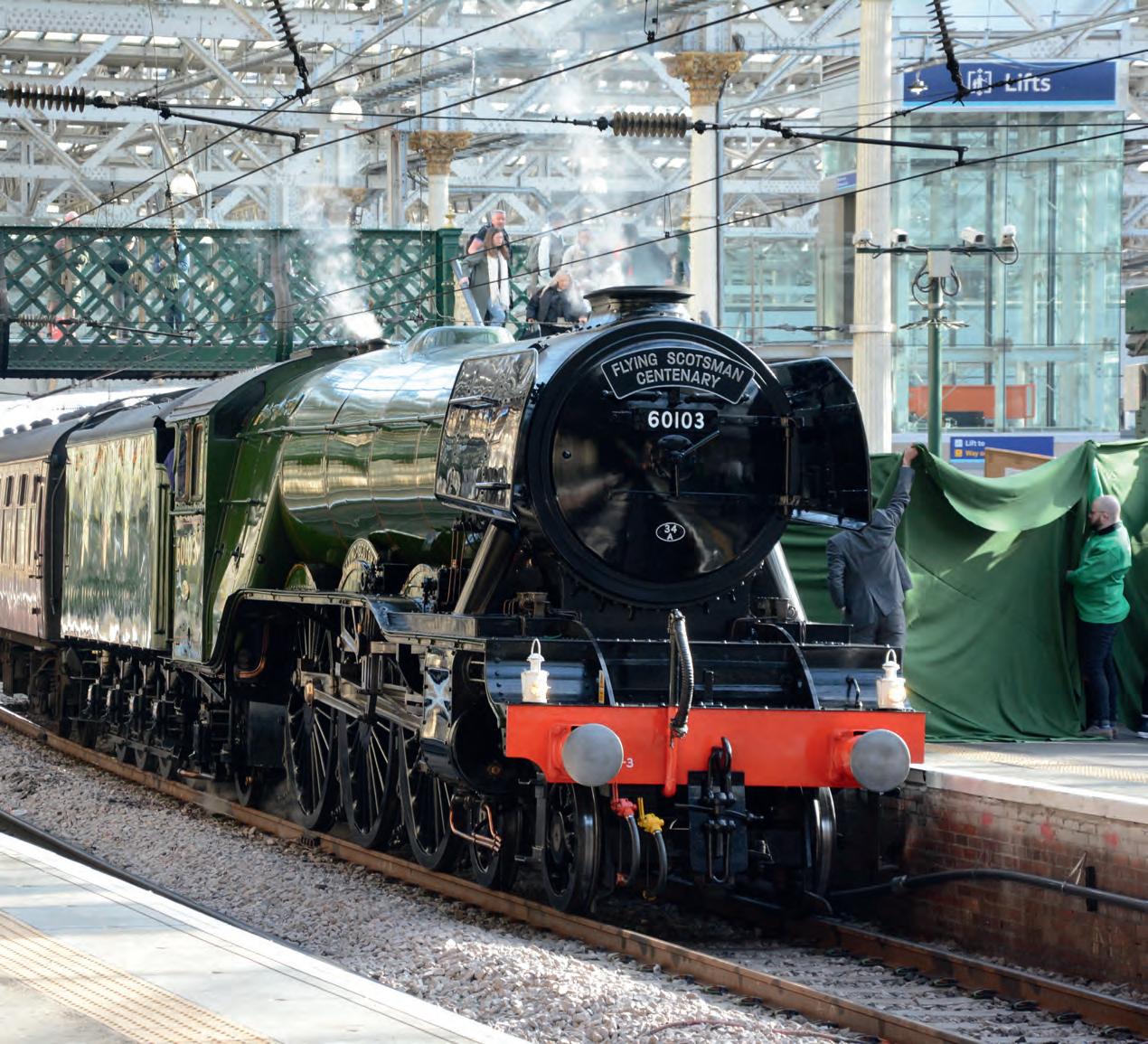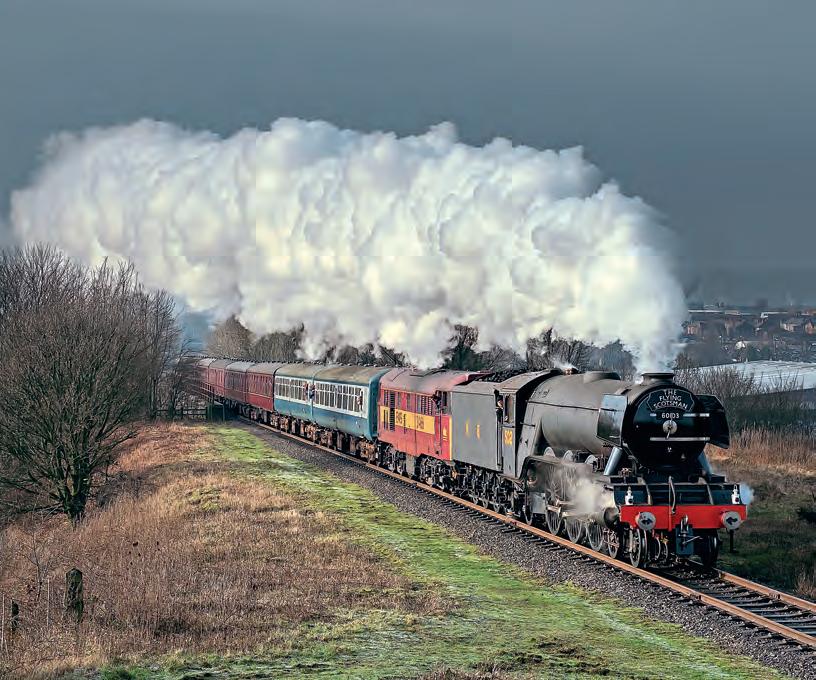






































The first locomotive of the newly-formed London & North Eastern Railway moved out of its Doncaster Works birthplace carrying the number 1472 on February 24, 1923, and went into service. The following year, what was also the first of Nigel Gresley’s Pacifics was named Flying Scotsman after the daily 10am London to Edinburgh service.

Over the century that followed, that unmistakable and unforgettable name became synonymous with the steam age and the time when Britain led the world in transport technology, and has long since been immortalised as a trademark of pride, inspiration and innovation and a defining icon of achievement.


After Flying Scotsman was withdrawn by British Railways after 40 years’ sterling service, it continued to fire the imagination of the general public who have remained enthralled by its appearances and adventures for generations. Flying Scotsman was twice saved for preservation, and during the heritage era continued to set new landmarks, including its record non-stop run of 422 miles, the longest by a steam locomotive, which it set during an historic tour of Australia in 1989.
Bought for the National Railway Museum in 2004 to ensure its permanent survival in the ownership of an admiring public, in 2023
Flying Scotsman celebrates its centenary in style with sell-out tours and crowd-pulling


special events throughout the country.
To mark its exact 100th birthday, on February 24 it appeared in steam at a special reception at Edinburgh Waverley station –which serves the city where its designer was born – and at which Poet Laureate Simon Armitage gave the first reading of his poem written especially for the occasion in honour of the legendary locomotive. It was followed on March 8 when it was crewed by an all-female team for the first time in its history, hauling three round trips on the East Lancashire Railway to mark International Women’s Day, another headline-grabbing world first.W
Now for the next 100 years of steam technology splendour! ●






006: CHAPTER 1 The most famous steam engine in the world
010: CHAPTER 2 The Great Northern Railway
014: CHAPTER 3 Herbert Nigel Gresley
018: CHAPTER 4 Gresley’s locomotive designs
020: CHAPTER 5 GNR locomotives
022: CHAPTER 6 Pacifics
024: CHAPTER 7 The Grouping
026: CHAPTER 8 ‘Flying Scotsman’ the train
028: CHAPTER 9 FlyingScotsman the engine
030: CHAPTER 10 Named trains
032: CHAPTER 11 What’s in a name?
036: CHAPTER 12 ‘The Ton’
040: CHAPTER 13 LNER Pacifics
042: CHAPTER 14 British Railways
048: CHAPTER 15 Alan Pegler: Scotsman’s saviour
052: CHAPTER 16 The National Collection
054: CHAPTER 17 The buyer’s tale
058: CHAPTER 18 Over the pond
062: CHAPTER 19 Sir William McAlpine
064: CHAPTER 20 Scotsman comes home
066: CHAPTER 21 Approved steam routes
068: CHAPTER 22 Steamtown Carnforth
070: CHAPTER 23 ‘Cumbrian Coast Express’
074: CHAPTER 24 This is York
078: CHAPTER 25 Settle & Carlisle
080: CHAPTER 26 Return to ‘The Smoke’
084: CHAPTER 27 Scotsmangoes Down Under
088: CHAPTER 28 Round the world
090: CHAPTER 29 No. 60103 on heritage lines
094: CHAPTER 30 The engineer’s tale
098: CHAPTER 31 Bought by another millionaire
100: CHAPTER 32 FlyingScotsman plc
RIGHT: In BR Brunswick green, which is also its current livery, No. 60103 FlyingScotsman prepares to depart from King’s Cross on January 14, 1963 on its last run for British Railways; the 1.15pm to Leeds. The engine was purchased for preservation by the late Alan Pegler who is seen standing on the bufferbeam. NATIONAL RAILWAY MUSEUM

BELOW: Still unnamed, LNER A1 Pacific No. 1472 emerges from Gasworks tunnel after leaving King’s Cross and passes Belle Isle with a Down express in 1923. NATIONAL RAILWAY MUSEUM
FRONT COVER MAIN: Gresley A3 Pacific No. 60103 FlyingScotsman arrives at Edinburgh Waverley on February 24, 2023 to celebrate its 100th birthday. JASON HYNES/NRM
COVER IMAGES INSET:
Left: Members of the all-female crew who took charge of FlyingScotsman at the East Lancashire Railway on March 8, 2023.
Centre: One of the new set of Royal Mail FlyingScotsman special collector stamps. ROYAL MAIL
102: CHAPTER 33 The director’s tale
104: CHAPTER 34 Scotsman for sale
106: CHAPTER 35 Save our Scotsman
110: CHAPTER 36 Saved for the nation
114: CHAPTER 37 Back to the future
118: CHAPTER 38 10 years to the day
122: CHAPTER 39 The legend awakens
129: CHAPTER 40 Sad farewells to two Scotsman greats
131: CHAPTER 41 King’s Cross launch for centenary year
134: CHAPTER 42 Scotsman heads for the south coast
137: CHAPTER 43 100th birthday celebrated in Edinburgh Waverley
142: CHAPTER 44 Flying Scotswomen!
147: FlyingScotsman centenary events and railtours
Right: A member of Celtic band the Red Hot Chilli Pipers welcomes centenarian FlyingScotsman to Waverley. PAUL PICKERDYKE
AUTHOR: Brian Sharpe with Robin Jones


DESIGN: atg-media.com and Druck Media Pvt. Ltd.
COVER DESIGN: Darren Hendley
PUBLISHER: Steve O’Hara
PUBLISHED BY: Mortons Media Group Ltd, Media Centre, Morton Way, Horncastle, Lincolnshire LN9 6JR Tel: 01507 529529

CREDITS: All pictures marked * are published under a Creative Commons licence. Full details may be obtained at http:// creativecommons.org/licences

ISBN: 978-1-911703-21-1

First published in 2016.
This expanded and updated edition © 2023 Mortons Media Group Ltd. All rights reserved. No part of this publication may be reproduced or transmitted in any form or by any means electronic or mechanical, including photocopying, recording, or any information storage retrieval system without prior permission in writing from the publisher.



No. 1472 was the third of a class of steam locomotives that was eventually to number 78 engines, and did not originally even carry a name. The Great Northern Railway A1 4-6-2 though, was the biggest express steam engine ever to have been seen in Britain at the time and was chosen to be displayed at a mojor exhibition at Wembley in 1924, for which it was given the name Flying Scotsman
It hauled the London & North Eastern Railway’s first King’s Cross-to-Edinhurgh nonstop express in 1928 and was the first steam engine in the world to officially break the 100mph barrier in 1934, although this speed had been unofficially claimed for a run by Great Western Railway 4-4-0 No. 3440 City of Truro 30 years earlier. An identical engine to Flying Scotsman soon eclipsed its record with a 108mph burst of speed in 1935.

Flying Scotsman was perhaps becoming the best-known of its class, but none of its record feats actually stood for long In 1935, Gresley’s original Pacifics were superseded by the A4s; streamlined engines with more speed and power, and these raised the speed record first to 112mph, and later to 126mph.
From then on, Flying Scotsman was just one of many engines that played a vital part in hauling East Coast Main Line expresses between King’s Cross, the north and Scotland, for another 30 years, but it had no more claim to fame than any of the others.
It still had its name though, and, when the final curtain came in early 1963 and the engine was withdrawn from service by British Railways and expected to be scrapped, it was purchased by a businessman who had every intention of keeping the engine running.
Flying Scotsman was certainly well known from the early years of its main line career, but it was 1963 when it really started to hit the headlines – after it had retired This might not have happened had the engine not had such a memorable name
Flying Scotsman has now become the one steam engine in the world of which many people know the name, and that most people would recognise It was briefly the only main line steam engine running in the whole of Britain, and it has travelled across the Atlantic and across America. It has circumnavigated the globe, steamed across Australia, broken the record for a nonstop run with steam (again), and been sold for easily the highest price ever paid for a steam engine
But it has had its down sides, too. It has had several owners, some of whom have bought
4472 Flying Scotsman departsfromChinleyandtakes theHope ValleylinetoSheffieldatChinleyNorthJunctionwithanenthusiasts’ railtourto YorkonSeptember29,1979. BRIANSHARPE Museumhashadits fingersburnt,butthatis nowhistory; FlyingScotsman isback!

ABOVE: InLNERapple green liveryascarriedfor56 yearsofits existence,andtheninthe ownershipofSirWilliamMcAlpine,No.
itonthestrengthofitsearningspotential, basedonthename FlyingScotsman.This valuehasperhapsbeenoverestimated,andtwo of FlyingScotsman’s one-timeownershave beenbankrupted.EventheNationalRailway
Ithasbeensaidthattheengine’sfameis suchthatitshouldhavebeenpreservedby thenationanyway.A largenumberofsteam
engineswerepreserved‘officially’andmany arenowondisplay intheNationalRailway MuseumatYork,but FlyingScotsman was simply notconsidered uniqueorhistorically importantenoughatthetimetobeincluded.
BELOW: HistoricallyincorrectinLNERapple greenliveryasNo. 4472butwith adouble chimneyandsmokedeflectors, Flying Scotsman preparestodepartfrom Yorkwithits first ‘ScarboroughSpaExpress’onJuly20,2004,afteritspurchase by theNationalRailwayMuseum. BRIANSHARPE
 008 Flying Scotsman
008 Flying Scotsman
In 2004 though, its ongoing 40 years of fame (if not fortune) finally earned it aplace in the National Railway Museumcollection and, after an unprecedented fundraising campaign and aNational Heritage Memorial Fund grant, the museumwas able to clear the enormousdebts of the engine’sthen-owning company and acquire Flying Scotsman for
thenation,andfor aBritishpublicthatclearly holdstheengineinhighesteem.
Ifithadnotacquiredfame,largely asa resultofitsname,inthe1920sand1930s, thenmaybeAlanPeglerwouldnothavehad theenthusiasmtopurchaseitin1963.Ifithad beenscrapped,whatwouldthenhavebecome ofBritain’smostfamoussteamengine?
Thequestioniswhether FlyingScotsman can runforever.Theanswerisprobably yes,ata price.Likeany steamengine,itis amechanical object,builtofsteel.Aspartswearoutthey

arereplaced.Littleoftheoriginalenginenow existsandtherehasbeenmuchrebuildingand improvementcarriedout,beforeandafter1963.

Andnowit’sback.No-oneexpecteditto take10 yearsoftoil,buttheNationalRailway Museum finally hasanenginetobeproud of.Thelegendthatis FlyingScotsman can runforever;andwillberecognisableas the ultimateinBritishexpresssteamdesign elegance.Itmay notbealltheoriginalsteel, butthelegendgoesfarbeyondtheengine’s physicalcharacteristics. •
Flying Scotsman is now celebrating its centenary year. Indeed, the legend that is Flying Scotsman will run forever; and the locomotive will be recognisable as the ultimate in British express steam design elegance. It may not be all the original steel, but the legend goes far beyond the engine’s physical characteristics. ●
 ABOVE: Backinsteamforthe firsttimein10 years,andin wartimeblacklivery, No.60103 Flying Scotsman assisted by Class31dieselNo.31466headsanEastLancashireRailwaytrainfromBurytowardsHeywoodonJanuary16, 2016. PHILJONES
ABOVE: BackinBRBrunswickgreenlivery, No.60103headsnorthontheECMLnear TuxfordwiththeinauguraltrainfromKing’sCrossto YorkonFebruary25,2016followingthe 10-year restorationafterpurchase by theNationalRailwayMuseum. MAURICEBURNS
ABOVE: Backinsteamforthe firsttimein10 years,andin wartimeblacklivery, No.60103 Flying Scotsman assisted by Class31dieselNo.31466headsanEastLancashireRailwaytrainfromBurytowardsHeywoodonJanuary16, 2016. PHILJONES
ABOVE: BackinBRBrunswickgreenlivery, No.60103headsnorthontheECMLnear TuxfordwiththeinauguraltrainfromKing’sCrossto YorkonFebruary25,2016followingthe 10-year restorationafterpurchase by theNationalRailwayMuseum. MAURICEBURNS

Britain’s first public steam-operated railway was the Stockton & Darlington, which opened in 1825. The Liverpool & Manchester moved the story on in 1830, but the early independent railways all had one thing in common; they had quite unimaginative names, such as the Bristol & Exeter Railway. As they grew bigger though, they coined names like the North Eastern or the Midland, and as they grew even bigger, the prefix ‘Great’ became popular, with the Great Western being quite an apt description of that railway, while the Great Northern was really a bit of an exaggeration. It was neither great in the way that the GWR covered the whole of western England, nor was it really northern, as its main line to the north ran only as far as just beyond Doncaster.
The Great Northern Railway had as its aim the building of a railway from London to York, by the shortest possible route. It was relatively late in setting out to achieve this, as other companies’ trains were already running between the two cities, but by a very circuitous route through Rugby and Derby.
The Act of Parliament authorising the construction in 1846 actually included two different routes, and the first section to be started was the line from Peterborough to Lincoln via Boston. In 1850 the line south was opened from Peterborough to a temporary London terminus at Maiden Lane, with the better-known King’s Cross station, located in a then very disreputable part of London, opening in 1852.
Lincoln to Doncaster via Gainsborough was not completed until 1867 so for a short period, the GNR’s expresses to the north ran via Boston to Lincoln, then over the Manchester Sheffield & Lincolnshire
Railway toDoncasterviaRetford.Somuch forthedirectrouteto York!By thetime King’sCross openedthough,theGNR’s ‘townsline’fromPeterboroughtoDoncaster, viaGrantham,NewarkandRetford,had beencompleted.
TheGNRneverreached York;itmadeit only asfarasAskernJunction,justnorthof Doncaster,fromwhereitstrainsranover Lancashire &YorkshireRailway tracksto Knottingley,thenoverpartoftheNorth EasternRailway to York.Itwasnot untilas lateas1871thattheNERbuilt amoredirect linesouthfromSelby tomeettheGNRat ShaftholmeJunctionjust afew yardsfrom AskernJunction,completingwhatwenow knowofastheEastCoastMainLinefrom King’sCrossto Edinburgh.Oneofthe principalAnglo-Scottishexpresseswasto becomeknown,though unofficially,asthe ‘FlyingScotsman’.
Competitionwas fierce,especially for Anglo-Scottishpassengerbusinessinthe 19thcentury.TrainsranfromKing’sCross, theGNRterminus,andEuston,theLNWR terminus,viatheeastcoastandwestcoast routesrespectively,beyondEdinburghto Aberdeen.TheeastcoastpartnersofGreat Northern,NorthEasternandNorthBritish railways,andtheirwestcoastopposite numbers,theLondon &North Westernand Caledonianrailwaysstagedthe‘Racestothe North’in1888and1895.
Despitetheroutebeinglongerandhillier, thewestcoastalliancewontheraceboth times.Butitwas theGNRthattended tobetheseniorpartnerintheeastcoast collaborationand,althoughitwasonthe losingside,itscontributionshouldnot be underestimated.Thetrackonitsmain
The Great Northern Railway had as its aim the building of a railway from London to York, by the shortest-possible route.

linewassomeofthebestinthecountry. Itsengineswereamongthefastestand mostreliable,anditscoachdesignswere adoptedasstandardforthe‘EastCoast JointStock’ fleetusedonAnglo-Scottish services.Despitethepublicrelations‘spin’
itschoiceofcompanynameimplied,the GreatNorthernwasoneofBritain’srailway companiesthatrarelygaveanyofitsengines names.Perhapsitsbest-known19th-century engine,thepioneerStirling8ftSingle,is simplyknownasNo.1.
Thenumerousindependentcompanies bearingthewell-knownnamesofthelate 19thcentury,whichbuiltBritain’srailway system,weretoamalgamateintolarger organisationsin1923,whentheGrouping formedtheBigFour.
 ABOVE: TheGreatNorthernRailway’smainline ranfromKing’sCrosstoDoncaster,withroutestoCambridge,Nottingham,SkegnessandGrimsby. ItalsoservedLeedsandBradford.The mapshowstheroutes remainingopenin2016,withtheGrimsbylineandotherroutesinLincolnshirehavingclosed by 1970,althoughshortsections remainedopenforfreighttrafficfor many yearsafterwards.
ABOVE: TheGreatNorthernRailway’smainline ranfromKing’sCrosstoDoncaster,withroutestoCambridge,Nottingham,SkegnessandGrimsby. ItalsoservedLeedsandBradford.The mapshowstheroutes remainingopenin2016,withtheGrimsbylineandotherroutesinLincolnshirehavingclosed by 1970,althoughshortsections remainedopenforfreighttrafficfor many yearsafterwards.